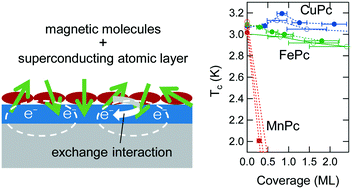Persistent superconductivity in atomic layer-magnetic molecule van der Waals heterostructures: a comparative study†
Abstract
The coexistence and competition of superconductivity and magnetism can lead to a variety of rich physics and technological applications. In this respect, recent discovery of atomic-layer superconductors offers opportunities to create new kinds of van der Waals two-dimensional (2D) heterostructures if magnetic molecules are self-assembled on the surface. Here we report on highly ordered 2D hybrid superconductors based on indium atomic layers on silicon surfaces and iron-phthalocyanine (FePc). Superconductivity was found to persist in the presence of spin magnetic moments of a closely packed FePc layer and its exchange-interaction with conduction electrons. This is in marked contrast to the previously reported strong suppression of superconductivity by manganese-phthalocyanine (MnPc), which has magnetic properties analogous to those of FePc. The origin of the distinctive behaviours of these heterostructures is discussed in terms of the Kondo effect as well as charge transfer and the exchange interaction between the two layers.

- This article is part of the themed collection: 2D materials: molecular design and engineering perspectives


 Please wait while we load your content...
Please wait while we load your content...